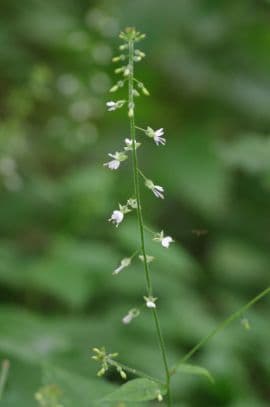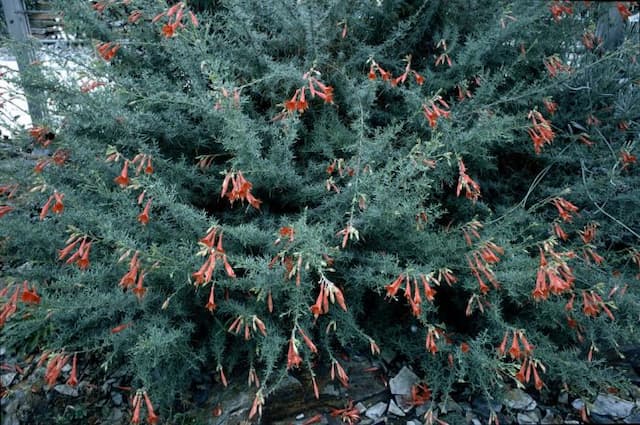Fuchsia Fuchsia 'Purple Rain'

ABOUT
Fuchsia 'Purple Rain' is a captivating plant known for its unique and vibrant display of flowers. The blooms dangle gracefully from the plant like decorative earrings, showcasing a fusion of deep purples and soft pinks. They consist of an outer layer of large, teardrop-shaped petals, often a rich purple or pink color, which elegantly encase the long, inner petals that typically exhibit shades ranging from a lighter pink to a nearly white hue. This striking contrast creates a pronounced, bell-like appearance that is quite alluring. The flowers are supported by thin, delicate stems which spring from bushy foliage. The leaves of Fuchsia 'Purple Rain' are generally a deep green color, and they form a lush backdrop that highlights the vivid colors of the flowers. The foliage may have a slight sheen to it, providing a sense of vitality and health that complements the ornate blooms. Overall, Fuchsia 'Purple Rain' exudes a sense of whimsy and flair. Its decorative blooms, paired with its vivid color palette, make it a standout plant that is often used in hanging baskets, containers, and garden borders, where its trailing habit and profuse flowering can be admired up close.
About this plant
 Names
NamesSynonyms
Lady's Eardrops, Fairy Bells, Hummingbird Fuchsia, Hardy Fuchsia.
Common names
Fuchsia 'Purple Rain'.
 Toxicity
ToxicityTo humans
Fuchsia 'Purple Rain', commonly known as Fuchsia, is not considered toxic to humans. Ingesting parts of the plant typically does not cause serious harm, but it is always best practice to avoid eating ornamental plants due to the potential for stomach upset or allergic reactions in sensitive individuals.
To pets
Fuchsia 'Purple Rain', commonly known as Fuchsia, is generally considered non-toxic to pets, including cats and dogs. While ingestion may cause some gastrointestinal discomfort, such as vomiting or diarrhea, it does not typically result in severe poisoning or long-term health consequences. However, monitoring your pet and consulting with a veterinarian is recommended if any unusual symptoms arise after ingestion.
 Characteristics
CharacteristicsLife cycle
Perennials
Foliage type
Deciduous
Color of leaves
Green
Flower color
Mixed
Height
1-2 feet (30-60 cm)
Spread
1-2 feet (30-60 cm)
Plant type
Shrub
Hardiness zones
9
Native area
Central America
Benefits
 General Benefits
General Benefits- Attractive Blooms: Features eye-catching, pendulous flowers that are rich in color, often with a unique two-tone effect.
- Long Flowering Season: Blossoms from late spring through fall, providing extended color and interest in the garden.
- Hummingbird Magnet: The nectar-rich flowers are highly attractive to hummingbirds, inviting wildlife into the garden.
- Versatile Use: Suitable for planters, hanging baskets, and as a bedding plant, offering flexibility in garden design and application.
- Shade Tolerant: Thrives in partial shade, where many other flowering plants may struggle, allowing for diverse planting situations.
- Easy to Care For: With suitable conditions, it is relatively easy to maintain, requiring regular watering and occasional feeding.
 Medical Properties
Medical PropertiesThis plant is not used for medical purposes.
 Air-purifying Qualities
Air-purifying QualitiesThis plant is not specifically known for air purifying qualities.
 Other Uses
Other Uses- As a natural dye: The vibrant blossoms of the Fuchsia can be used to create a natural plant dye for textiles, offering hues from pink to purple.
- In creating edible flower arrangements: Fuchsia flowers are edible and can be used to add color and a slightly tart flavor to salads or as a garnish for desserts and drinks.
- As a teaching tool for botany: Fuchsia 'Purple Rain' can be used in educational settings to teach about plant biology and hybridization due to its distinct characteristics and hybrid nature.
- For bonsai: With careful pruning and training, this plant can be cultivated as a bonsai, providing a unique challenge for enthusiasts of miniature trees.
- In photography: The striking blooms of the Fuchsia 'Purple Rain' serve as excellent subjects for photographers looking to capture the beauty of flowers and the intricacies of plant structure.
- As a model organism in horticultural studies: Researchers can use the Fuchsia 'Purple Rain' to study plant growth, flowering patterns, and responses to various environmental conditions.
- As a living sculpture: Creative gardeners can train and shape Fuchsia 'Purple Rain' into living sculptures or topiaries as part of an ornamental garden design.
- In scent gardens: Although not known for a strong fragrance, the subtle scent of the Fuchsia flowers can contribute to a multi-sensory experience in gardens designed for smell.
- For color-themed events: Fuchsia 'Purple Rain' can be incorporated into event decor for weddings or parties that have a purple color theme, adding natural beauty and consistency to the event’s aesthetic.
- As a natural insect attractant: The flowers can help attract pollinators like bees, butterflies, and hummingbirds to a garden, supporting biodiversity.
Interesting Facts
 Feng Shui
Feng ShuiThe Fuchsia is not used in Feng Shui practice.
 Zodiac Sign Compitability
Zodiac Sign CompitabilityThe Fuchsia is not used in astrology practice.
 Plant Symbolism
Plant Symbolism- Grace: The elegant, teardrop shape of the Fuchsia flower is often associated with grace and poise, making it symbolic of these characteristics.
- Good Taste: With its exquisite appearance and rich colors, Fuchsia is thought to represent good taste and sophistication.
- Confiding Love: Victorians might have used Fuchsia to communicate confidences of the heart, as flowers were often used to convey specific sentiments during that time.
- Amiability: Fuchsia's friendly and inviting appearance can signify warmth, kindness, and a pleasant disposition.
- Overflowing Abundance: The profusion of Fuchsia blossoms, especially in the 'Purple Rain' variety, can symbolize an overflowing abundance, whether it is in love, kindness, or wealth.
 Water
WaterFuchsia 'Purple Rain', commonly known as hardy fuchsia, should be watered regularly, ensuring the soil remains moist but not soggy. During the growing season, this typically means watering it once or twice a week, depending on the climate and weather conditions. Use approximately half a gallon of water for each watering session for a standard potted plant. It's crucial to reduce the frequency of watering during the fall and winter months when the plant is not actively growing.
 Light
LightFuchsia 'Purple Rain' thrives in bright, indirect light. It is best placed in a spot where it receives morning sunlight and afternoon shade, as intense afternoon sun can scorch its delicate leaves. A north-facing or east-facing window would be an ideal location for hardy fuchsia to receive the appropriate amount of light it needs to flourish without being exposed to excessive direct sunlight.
 Temperature
TemperatureFuchsia 'Purple Rain' prefers a cooler temperature range, ideally between 55 and 75 degrees Fahrenheit. It can survive short periods outside this range, but temperatures below 50 degrees or above 80 degrees may stress the plant. The ideal conditions are those that simulate its native environment, which includes cool summers and mild winters, avoiding the extremes of hot or freezing temperatures.
 Pruning
PruningFuchsia 'Purple Rain' benefits from regular pruning to promote bushy growth and abundant flowering. Prune in late winter or early spring before new growth begins, removing dead or weak branches and shaping the plant. Additionally, after the first flush of flowers fades, light pruning encourages a second bloom. Pruning is often done annually or as needed to maintain the desired form.
 Cleaning
CleaningAs needed
 Soil
SoilThe Fuchsia 'Purple Rain' thrives in a well-draining, fertile, and moist soil mix with good aeration. A mix of loam, peat moss, and sand or perlite is beneficial, potentially with a slow-release fertilizer added. For optimal growth, the soil pH should range between 6 to 7.
 Repotting
RepottingFuchsia 'Purple Rain' should generally be repotted every 2-3 years or when it outgrows its container. Choose a slightly larger pot to encourage continued growth and replace the soil to ensure nutrient availability.
 Humidity & Misting
Humidity & MistingFuchsia 'Purple Rain' prefers high humidity levels, typically around 60-70%. It benefits from humid conditions but should have good air circulation to prevent disease.
 Suitable locations
Suitable locationsIndoor
Place in bright indirect light with high humidity.
Outdoor
Partial shade, sheltered from wind, moist soil.
Hardiness zone
10-11 USDA
 Life cycle
Life cycleFuchsia 'Purple Rain' begins its life as a seed, which, when provided with the appropriate conditions of moisture and temperature, germinates to produce a small seedling. The seedling grows into a young plant through the vegetative stage, developing a root system and foliage. As the plant matures, it enters the flowering stage, producing distinctive purple and red blooms that attract pollinators. Following pollination, the plant sets fruit, which are small, dark berries containing seeds. After fruiting, if growing conditions are less than optimal, the plant may enter a period of dormancy, particularly in cooler climates. With the return of favorable conditions, the plant can resume growth, and the cycle can begin again with the germination of new seeds.
 Propogation
PropogationPropogation time
Spring-Early Summer
Fuchsia 'Purple Rain', commonly referred to as hardy fuchsia, is most commonly propagated through softwood cuttings. This method is particularly popular as it is quite straightforward and successful. During the late spring to early summer when the plant is actively growing, you would take a cutting of about 3 to 5 inches (approximately 7.5 to 12.5 centimeters) from new growth, ensuring that it has a few leaves. After removing the bottom leaves, the cutting is often dipped in rooting hormone to encourage root development and then planted in a moist potting mix. Maintaining a warm environment and high humidity around the cutting, such as can be achieved with a plastic cover, encourages rooting. Roots typically develop within a few weeks, after which the new plant can be gradually acclimatized to less humid conditions before planting out.









